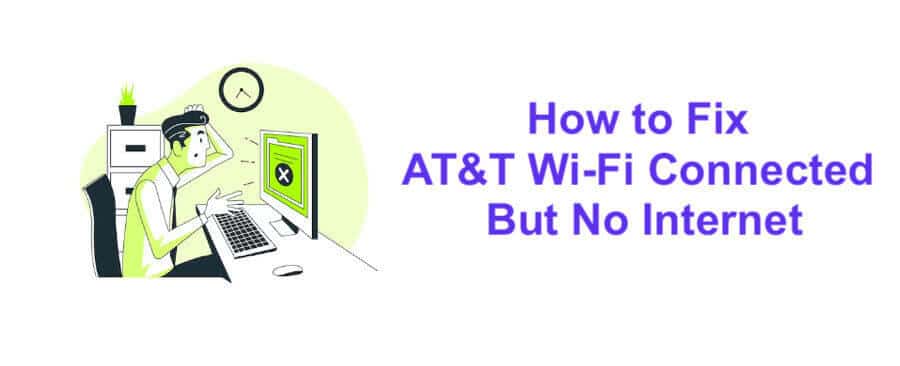AT&T is a popular internet service provider in the United States. However, like any other internet service, it can sometimes experience problems. One common problem is when the Wi-Fi is connected, but there is no Internet. This can be frustrating, but you can do a few things to fix it.
This article will discuss the most common causes of AT&T Wi-Fi problems and how to fix them. We will also provide some tips for preventing these problems from happening in the future.

Causes for AT&T Wi-Fi Problem
If you can’t access any website or app but your Wi-Fi says connected, there could be one of the following common reasons.
- ISP is down.
- Faulty router or Wi-Fi adapter.
- A problem with the AT&T gateway. The AT&T gateway is the device that connects your home to the Internet. If there is a problem with the gateway, it can cause your WiFi to stop working.
- There is a problem with the cables connecting the gateway to your modem and devices. Make sure that all of the wires are properly plugged in and that there are no loose connections.
- Interference from other devices. Microwaves, cordless phones, and baby monitors can interfere with WiFi signals. If you are having problems with your WiFi, try moving your gateway away from these devices.
- Outdated wireless drivers.
- Security software interfering with internet access.
AT&T Wi-Fi Connected But No Internet – Troubleshooting Tips
As per recent reports, many AT&T users have resorted to the forums expressing their inability to access the Internet despite Wi-Fi being connected.
If you are one of the AT&T users facing the same “AT&T Wi-Fi connected but no internet” issue, we have put together all the required troubleshooting tips to deal with the problem to enjoy seamless Internet.
Check Internet Status
Before you start troubleshooting, ensure there isn’t an outage in your area. You can visit AT&T’s official website or use their customer service line to check for reported outages. If there’s a known outage, the best thing to do is wait for AT&T to resolve the issue.
Restart Your AT&T Router/Gateway
One of the simplest and most basic troubleshooting tips to fix minor internet problems is to restart your router. To do this, unplug the power cord from the back of your gateway and wait 30 seconds. Then, plug the power cord back in and wait for the green lights to blink. Hopefully, the ‘No Internet’ issue is now resolved.
Change Router Location
If you have put your router within a cabinet or appliances are closely positioned to the router, you may experience connectivity issues. Shift your router and place it strategically to connect well to all the areas in your home.
Ensure that you’re within a reasonable range of the WiFi router. If the signal strength is weak, your device might show a connection but won’t be able to access the Internet properly. Walls and obstacles can interfere with the signal, so try moving closer to the router.
Use Another Browser
On most occasions, the browser prevents you from accessing a webpage. Simply trying a different browser can solve the ATT Internet problem.
Reboot Your Computer
Sometimes, the problem might be with your device rather than the WiFi connection. Start by restarting the device (computer, smartphone, tablet, etc.) that’s having trouble connecting.
You need to check whether the “Wi-Fi connected but no internet issue” occurs on all your devices or impacts a single device. Try connecting to the WiFi on a different device to determine if the problem is specific to one device or affecting all of them. If the issue is device-specific, the problem might be with that device’s settings.
Check Wi-Fi or Device Settings
Have you recently made changes to your computer or router settings? Installing new software or updating settings sometimes doesn’t go well with your Wi-Fi network. To fix this, you should immediately undo the recent changes.
Disable Firewall/Antivirus
Temporarily turn off your computer’s firewall and antivirus software to see if they are causing the issue. If the connection starts working, you must adjust your software settings to allow the WiFi connection.
In addition, you may scan your system for malicious programs, viruses, malware, or other infections.
Disable VPNs or Proxies
If you’re using a VPN or proxy server, disable them and try connecting again. These services can sometimes interfere with your internet connection.
Contact AT&T Support
If you have tried all the above steps and your AT&T WiFi is still not working, you may need to contact AT&T customer support for further assistance. They can guide you through more advanced troubleshooting steps and might even send a technician if the problem is on their end.
Here are some additional tips to help you troubleshoot your AT&T WiFi connection:
- Make sure that your devices are compatible with the WiFi network.
- Check for interference from other devices, such as microwaves, cordless phones, and baby monitors.
- Move your gateway to a more central location in your home.
- Try using a WiFi extender or mesh network to improve the signal strength in your home.

